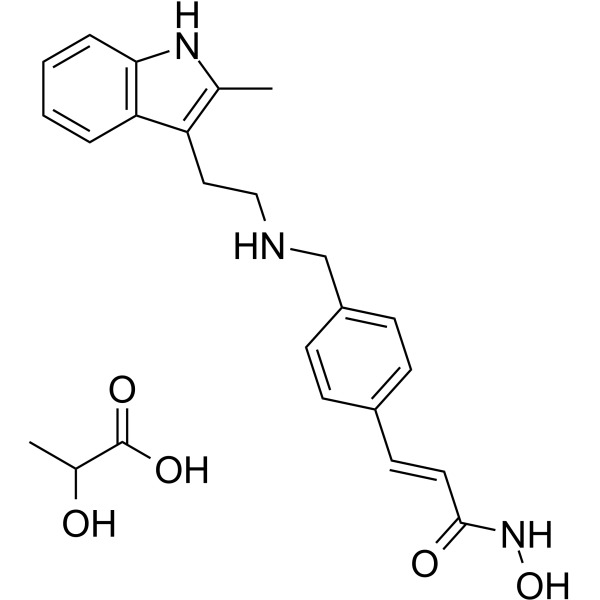960055-56-5
| Name | panobinostat lactate |
|---|---|
| Synonyms |
UNII-HN0T99OO4V
(E)-N-hydroxy-3-[4-[[2-(2-methyl-1H-indol-3-yl)ethylamino]methyl]phenyl]prop-2-enamide,2-hydroxypropanoic acid |
| Description | Panobinostat lactate is a potent and orally active non-selective HDAC inhibitor. Panobinostat lactate has antineoplastic activities. Panobinostat lactate effectively disrupts HIV latency. Panobinostat lactate induces cell apoptosis and autophagy. Panobinostat lactate can be used for the study of refractory or relapsed multiple myeloma[1][2][3][4][5]. |
|---|---|
| Related Catalog | |
| Target |
HDAC HIV-1 |
| In Vitro | Panobinostat lactate induces apoptosis of both MOLT-4 and Reh cells in a time- and dose-dependent manner. Panobinosta lactate results in histone (H3K9 and H4K8) hyperacetylation and regulation of cell-cycle control genes in Reh cells[1]. Panobinostat lactate exhibites potent antiproliferative activity in human NSCLC cell lines with the IC50 ranging from 5 to 100 nM[2]. |
| In Vivo | Panobinosta lactate (10, 20 mg/kg, i.p.) significantly slows tumor growth derived from Meso and NSCLC cells in vivo models. Panobinosta lactate markedly increases acetylation of histone H3 and H4 of H69 human SCLC cells harvest from SCID mice[2]. Panobinostat lactate (5, 10 and 20 mg/kg i.p.) demonstrates a clear benefit of decreased tumor burden, significantly improves TTE and reduces bone density loss in a disseminated multiple myeloma mouse model[3]. |
| References |
| Molecular Formula | C24H29N3O5 |
|---|---|
| Molecular Weight | 439.50400 |
| Exact Mass | 439.21100 |
| PSA | 138.17000 |
| LogP | 4.01020 |
| Storage condition | -20°C |
